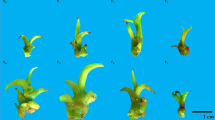Abstract
The effects of host plant exudates, light and temperature on germination of oospores of Peronospora viciae f.sp. pisi in vitro were investigated. Seed and root exudates did not increase percentage germination, whereas light inhibited germination. The first germ tubes appeared after 4, 7, and 14 days of incubation at 15, 10 and 5 °C, respectively. The eventual level of germination was highest and had similar values at 5 and 10 °C. At 20 °C germination was poor and at 25 °C no germination was observed. Oospores placed on membrane filters were incubated on soil. When oospores were retrieved from the membrane filters after six days and placed in water at 10 °C, they germinated within 2 days. On soil significantly less oospores germinated than in water. Germinability of oospores stored in the dark at 5 or 20 °C at 30 or 76% RH was studied over a two-year period. Germinability generally increased over time, but fluctuations were observed indicating the occurrence of secondary dormancy. Time courses of germinability were generally similar for oospores stored at several temperatures and humidities. No effect of light on time course of germinability was found when oospores were exposed to alternating light-dark periods or stored in continuous dark for 140 days. Percentage germination observed in a germination assay was correlated with percentage infection determined in a bioassay.
Similar content being viewed by others
References
Baker KF and Cook RJ (1974) Biological control of plant pathogens. WH Freeman and Company, San Francisco. 433 pp
Boerema GH, P ieters R and Hamers MEC (1993) Check-list for scientific names of common parasitic fungi. Supplement Series 2c, d (additions and corrections): Fungi on field crops: pulse (legumes), forage crops (herbage legumes), vegetables and cruciferous crops. Netherlands Journal of Plant Pathology 99. Supplement 1: 1–32
Bruehl GW (1987) Soilborne plant pathogens. MacMillan, New York. 368 pp
Clark JSC (1989) Nutrient transport and resistance in downy mildew of pea. Ph.D. thesis. Bristol Polytechnic, UK
Dixon GR (1981) Downy mildews on peas and beans. In: Spencer DM (ed) The downy mildews (pp 487–515) Academic Press, London
El-Hamalawi ZA, and Erwin DC (1986) Physical, enzymic, and chemical factors affecting viability and germination of oospores of Phytophthora megasperma f.sp. medicinagis. Phytopathology 76: 503–507
F¨orster H, Ribeiro OK and Erwin DC (1983) Factors affecting oospore germination of Phytophthora megasperma f.sp. medicinagis. Phytopathology 73: 442–448
Geesteranus HP (1961)Valsemeeldauw (Peronospora viciae (Berk.) Casp.). In: Jaarverslag Instituut voor Plantenziektenkundig Onderzoek Wageningen. pp 45–48
Gomez KA and Gomez AA (1984) Statistical procedures for agricultural research. John Wiley & Sons, New York
Günther M (1992) Untersuchungen zu Pathotypenidentifizierung von Perononspora pisi Syd. und zum Resistenzverhalten von Pisum sativum L. PhD Thesis, Freien Universität Berlin
Hord MJ and Ristaino JB (1991) Effects of physical and chemical factors on the germination of oospores of Phytophthora capsici in vitro. Phytopathology 81: 1541–1546
Morgan WM (1978) Germination of Bremia lactucae oospores. Transactions of the British mycological Society 71: 337–340
Morgan WM (1983) Viability of Bremia lactuceae oospores and stimulation of their germination by lettuce seedlings. Transactions of the British Mycological Society 80: 403–408
Moser EB and Saxton AM (1990) Repeated measures analysis of variance: application to tree research. Canadian Journal of Forest Research 20: 524–535
Pegg GF and Mence MJ (1970) The biology of Peronospora viciae on pea: laboratory experiments on the effects of temperature, relative humidity and light on the production, germination and infectivity of sporangia. Annals of Applied Biology 66: 417–428
Pratt RG (1978) Germination of oospores of Sclerospora sorghi in the presence of growing roots of host and non-host plants. Phytopathology 68: 1606–1613
Reiling TP (1984) Downy mildew. In: Hagendorn DJ (ed) Compendium of Pea Diseases (pp 19–21) American Phytopathological Society
Ribeiro OK (1983) Physiology of asexual sporulation and spore germination. In: Erwin DC, Bartnicki-Garcia S and Tsao PH (eds) Phytophthora: Its Biology, Taxonomy, Ecology, and Pathology (pp 55–70) American Phytopathological Society, St. Paul, MN
Roberts EH and Smith RD (1977) Dormancy and the pentose phosphate pathway. In: Khan AA (ed) The physiology and biochemistry of seed dormancy and germination (pp 385–411) Elsevier/North Holland Biomedical Press
Ryan EW (1971) Two methods of infecting peas systemically with Peronospora pisi, and their application in screening cultivars for resistance. Irish Journal of Agricultural Research 10: 315–322
Stegmark R (1991) Comparison of different inoculation techniques to screen for resistance of pea lines to downy mildew. Journal of Phytopathology 133: 209–215
Stegmark R (1994) Downy mildew on peas (Peronospora viciae f.sp. pisi). Agronomie 14: 641–647
Sutherland ED and Cohen SD (1983) Evaluation of tetrazolium bromide as a vital stain for fungal spores. Phytopathology 73: 1532–1535
Van der Gaag DJ (1994) The effect of pH on staining of oospores of Peronospora viciae with tetrazolium bromide. Mycologia 86: 454–457
Van der Gaag DJ and Frinking HD (1996a) Homothallism in Peronospora viciae f.sp. pisi and the effect of temperature on oospore production. Plant Pathology 45: 990–996
Van der Gaag DJ and Frinking HD (1996b). Extraction from plant tissue and germination of oospores of Peronospora viciae f.sp. pisi. Journal of Phytopathology 144: 57–62
Van der Plank JE (1975) Principles of plant infection. Academic Press, New York
Von Heydendorff RC (1977) DeUntersuchungen zur Biologie von Peronospora pisi Syd., dem Erreger des falschen Mehltaus an Erbsen, als Grundlage für die Züchtung resistenter Sorten. Ph.D. Thesis, Technischen Universität Hannover
Zadoks JC and Schein RD (1979) Epidemiology and plant disease management. Oxford University, New York, Oxford
Author information
Authors and Affiliations
Rights and permissions
About this article
Cite this article
van der Gaag, D.J., Frinking, H.D. Factors affecting germination of oospores of Peronospora viciae f.sp. pisi in vitro. European Journal of Plant Pathology 103, 573–580 (1997). https://doi.org/10.1023/A:1008607100742
Issue Date:
DOI: https://doi.org/10.1023/A:1008607100742




